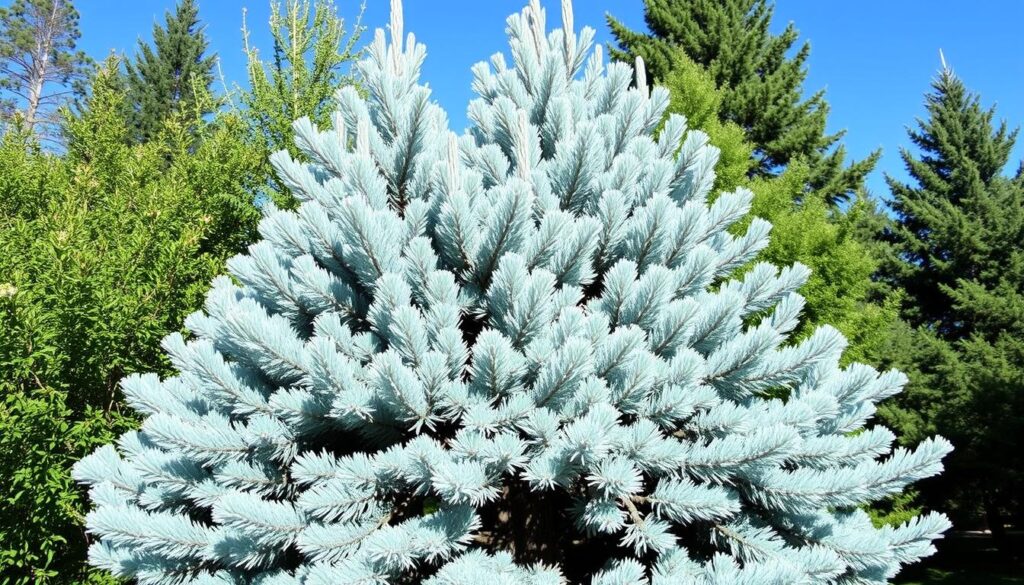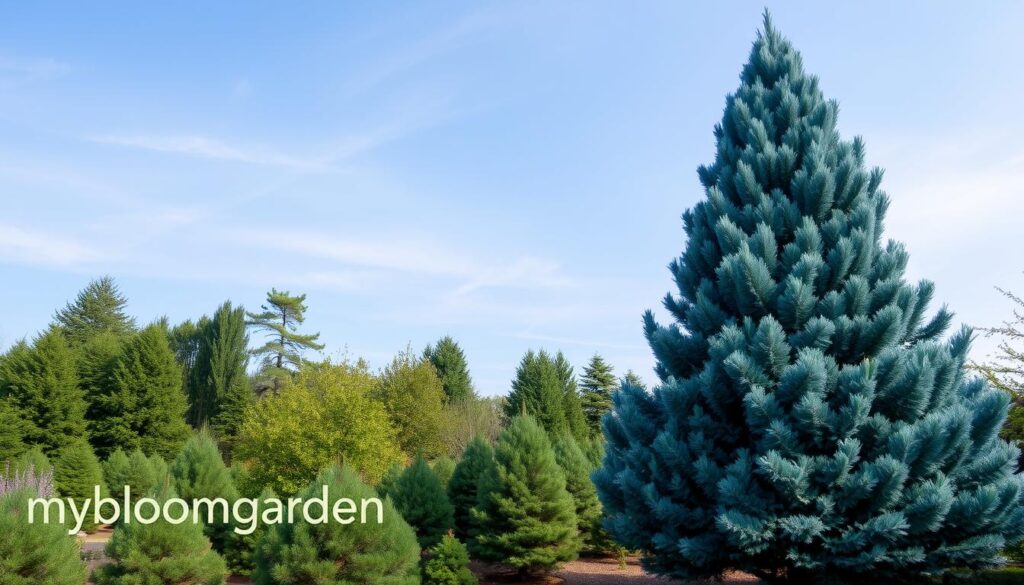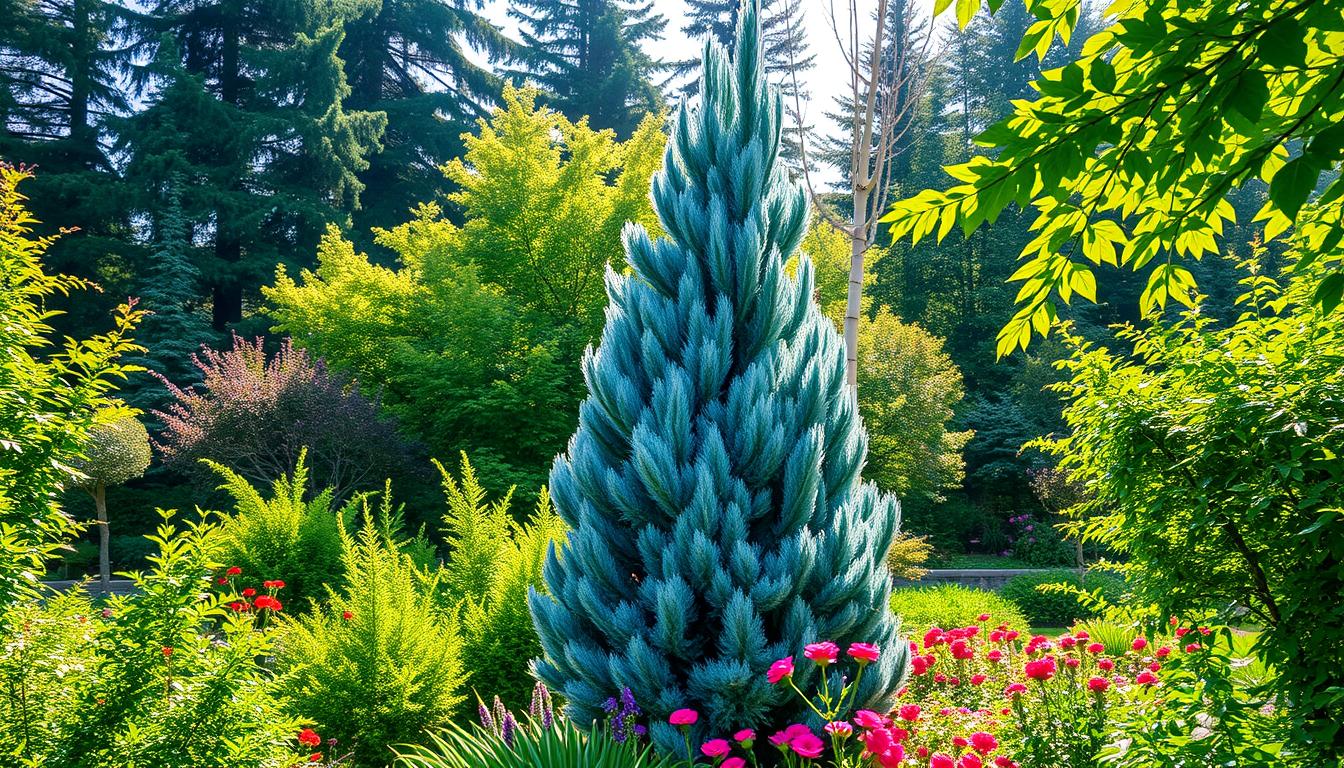As the sun set, it cast a warm glow over my backyard. I was drawn to the Colorado blue spruce tree. Its silver-blue leaves seemed to shimmer in the light, a beautiful sight that had been there for years. I wanted to learn how to care for this tree and share what I found with others.
The blue spruce is a standout in gardening, known for its color, shape, and toughness. This guide is for anyone who wants to grow a blue spruce tree. It will help you learn how to care for one in your own backyard.
Table of Contents
Introduction to BLUE Spruce: Nature’s Living Masterpiece
The Colorado blue spruce, also known as Picea pungens, is a beautiful evergreen tree. It has won the hearts of many gardeners and landscapers. This tree comes from the Rocky Mountains in the United States and is a favorite in horticulture.
Native Habitat and Natural Distribution
The blue spruce grows in western North America. It can be found from the central Rocky Mountains to the southwestern United States. This tree loves the cool, dry weather of places like Colorado, Utah, and Wyoming.
Distinctive Features and Characteristics
The Colorado blue spruce is known for its blue-green leaves. These leaves can also be silvery-blue or steel-blue. Its tall, symmetrical shape makes it a beautiful addition to any garden.
Common Uses in Landscaping
The blue spruce is a favorite for landscaping because of its beauty and toughness. It’s often the centerpiece of gardens, adding elegance. Its dense growth is also great for creating privacy and windbreaks.
“The Colorado blue spruce is a true masterpiece of nature, captivating the senses with its striking blue-green hues and majestic stature.”
Selecting the Perfect Location for Your Blue Spruce Tree
Choosing the right spot for your blue spruce is crucial. This evergreen tree needs specific conditions to thrive. Knowing what it needs ensures it stays healthy and grows well.
Here are key factors to consider for the perfect spot for your blue spruce seedlings:
- Sunlight Exposure – Blue spruces love full sun, needing at least 6 hours of direct sunlight daily. Don’t plant in very shaded spots.
- Soil Conditions – They prefer soil that drains well and is rich in nutrients, with a slightly acidic pH. Make sure the soil is right for the best growth.
- Spacing Requirements – These trees can grow big, up to 80 feet tall and 40 feet wide. Give them enough room for growth, air, and roots.
By picking the right spot, you’ll help your blue spruce tree thrive. It will become a beautiful centerpiece in your yard.
“The key to success in growing blue spruce is finding the perfect spot that mimics their natural habitat.”
Essential Soil Requirements and Ground Preparation
Growing a thriving blue spruce tree starts with the right soil. This evergreen, known as the “Colorado blue spruce,” needs specific soil to grow well. It’s key to your landscape’s beauty.
Optimal Soil pH Levels
The blue spruce tree loves well-drained, slightly acidic soil. It should have a pH between 5.5 and 6.5. This pH helps the tree absorb nutrients, promoting healthy growth and vibrant leaves. If your soil pH is off, adjust it before planting your blue spruce.
Drainage Considerations
Good drainage is vital for your blue spruce. These trees and shrubs can’t handle waterlogged soil. It causes root rot and other problems. Make sure your planting site drains well or use raised beds for better drainage.
Soil Amendment Techniques
- For heavy or clay-based soils, add compost or peat moss. It improves drainage and aeration.
- On sandy or nutrient-poor soils, use a balanced fertilizer or blue spruce spruce specific formula. It provides the needed nutrients.
- Apply mulch around the tree’s base. It keeps moisture in and weeds out.
With the right soil preparation, your blue spruce tree will thrive. It will become a stunning part of your landscape for years.
Planting Colorado Blue Spruce: Step-by-Step Guide
Planting colorado blue spruce saplings or blue spruce seedlings needs careful attention. This ensures the long-term health and vibrant growth of these stunning evergreen trees. Follow this step-by-step guide to properly plant your blue spruce and give it the best possible start.
- Select the Perfect Planting Site: Choose a location that receives full sun exposure and has well-drained soil. Avoid areas with heavy foot traffic or near underground utilities.
- Prepare the Planting Hole: Dig a hole that is two to three times the width of the root ball and just as deep. The hole should have sloping sides to make it easier for the roots to spread outward.
- Set the Tree in Place: Carefully lower the blue spruce into the planting hole, ensuring the top of the root ball is level with the surrounding soil. Make any necessary adjustments to the depth.
- Backfill and Water: Gently backfill the hole with the original soil, tamping it down to remove any air pockets. Water the tree thoroughly to saturate the soil and roots.
- Mulch and Stake: Apply a 2-4 inch layer of organic mulch around the base of the tree, but avoid piling it against the trunk. If needed, use stakes to support the tree until it becomes established.
Remember, the key to successfully planting colorado blue spruce saplings or blue spruce seedlings is to provide the right conditions, proper soil preparation, and consistent care in the first few years after planting. With these steps, you’ll be well on your way to enjoying the majestic beauty of a thriving blue spruce in your landscape.
Watering Schedule and Moisture Management
Keeping the right moisture levels is key for your blue spruce tree’s health and growth. Knowing when to water and how to spot watering problems helps your tree stay healthy all year.
Seasonal Watering Requirements
Blue spruce trees need different amounts of water at different times. In spring and summer, when they’re growing fast, they need more water. But in fall and winter, when they’re dormant, they need less to avoid too much water.
- Spring and Summer: Water your blue spruce tree deeply once or twice a week, ensuring the soil remains consistently moist but not waterlogged.
- Fall and Winter: Reduce watering to once every two to three weeks, allowing the soil to partially dry out between waterings.
Signs of Over and Under-Watering
Watching your blue spruce tree closely can help you spot moisture problems. Knowing the signs of too much or too little water lets you adjust your watering schedule as needed.
- Signs of overwatering: Yellowing or wilting needles, soft or mushy stems, and the presence of fungal growth or mold.
- Signs of underwatering: Dry, brittle needles, brown or wilting foliage, and stunted growth.
By sticking to a balanced watering plan and watching for signs of moisture stress, your blue spruce tree will stay healthy and vibrant all year.
Fertilization and Nutrient Requirements
To keep your Colorado blue spruce or blue spruce trees healthy, you need to fertilize them right. These evergreen giants need specific nutrients for the best growth and look.
Timing and Frequency of Fertilization
Fertilize your blue spruce trees in early spring when new growth starts. This way, the nutrients are available when the tree needs them most. Fertilize once a year since these trees need a moderate amount of nutrients.
Organic and Inorganic Fertilizer Options
Both organic and inorganic fertilizers work well for Colorado blue spruce trees. Organic options like compost or well-rotted manure slowly release nutrients and improve soil. Inorganic fertilizers give a quick nutrient boost but must be used carefully to avoid over-fertilizing.
“Regular fertilization is key to maintaining the vibrant blue-green hue and dense foliage of blue spruce trees.”
Macronutrient and Micronutrient Needs
- Nitrogen (N) helps with healthy growth and lush leaves.
- Phosphorus (P) supports strong roots and plant vigor.
- Potassium (K) helps trees handle drought and cold better.
- Micronutrients like iron, zinc, and manganese are also crucial for blue spruce trees’ health.
Knowing what your blue spruce trees need and using a balanced fertilization plan will help them thrive in your landscape for many years.

Pruning and Shaping Techniques for Healthy Growth
To keep your blue spruce tree looking great, you need to prune and shape it right. These steps not only make your tree look good but also help it grow well. Let’s dive into how to prune and shape your blue spruce for a beautiful landscape.
Timing Your Pruning Sessions
The best time to prune your blue spruce is in late winter or early spring. This is before new growth starts. It helps the tree heal fast and reduces disease or pests. Don’t prune in summer because the tree is growing a lot and can get stressed.
Tools and Methods
Choosing the right tools is key for pruning your blue spruce. Use sharp, clean shears or a saw for clean cuts. Dull or damaged tools can harm the tree. For big branches, a hand saw or pole pruner might be needed.
When you prune, take out dead, damaged, or crossing branches. Cut just above an outward-facing bud or branch. This helps the tree grow in the right direction. Don’t cut the main leader, as it can mess up the tree’s shape and growth.
To shape your blue spruce, like a tight pyramid, regular pruning is a must. Use thinning cuts to remove some branches. But don’t top or shear the tree, as it can harm its natural growth.
“Proper pruning and shaping techniques are the keys to maintaining the stunning, lush appearance of your blue spruce tree for years to come.”
By following these pruning and shaping tips, your blue spruce will stay healthy and beautiful. Always be careful and talk to a professional arborist if you’re not sure about pruning.
Common Diseases and Pest Management
Colorado blue spruce trees are truly majestic. But, they can face diseases and pests that harm their health and look. It’s important to know about these issues to keep your trees looking their best.
Needle cast is a common disease. It makes the needles turn brown and fall off. To fight it, you need to prune affected branches and use fungicides.
Spider mites are another problem. These tiny bugs eat the needles, causing them to turn yellow and weak. Watch for signs like webbing and treat with insect sprays to control them.
Blue spruce trees also deal with environmental stress like winter desiccation and frost cracks. Using wind barriers or burlap wraps can protect them during harsh winters.
By watching for diseases and pests and acting fast, you can keep your blue spruce facts and colorado blue spruce trees looking great for many years.
Growth Rate and Size Expectations
The Colorado blue spruce is a stunning evergreen tree. It grows slowly but steadily. This makes it a favorite for landscaping and gardening.
Annual Growth Patterns
This tree grows about 6 to 12 inches each year. Growth depends on soil, sunlight, and climate. It grows slowly, becoming a beautiful part of your outdoor space.
Maximum Height and Spread
Colorado blue spruce trees can grow up to 80 feet tall. They spread 20 to 30 feet wide. But, size varies with growing conditions and type.
Some varieties are smaller, reaching 15 to 25 feet. Plan your planting space carefully. This ensures your tree has room to grow.

“The Colorado blue spruce is a slow-growing, majestic tree that can add timeless beauty to any landscape.”
Winter Care and Protection Strategies
As winter gets closer, it’s key to get your blue spruce tree ready. These evergreen giants face harsh winter conditions. With a few simple steps, you can help your tree stay healthy all season.
Safeguarding Against Winter Burn
Winter burn can harm your blue spruce’s leaves. It happens when cold winds and bright sun meet. Wrap the lower branches and trunk with burlap or a tree wrap to protect them.
Managing Snow Accumulation
Too much snow can break your blue spruce’s branches. Gently remove snow with a soft brush or broom. Don’t shake the tree to avoid more damage.
Caring for Young Blue Spruce Trees
New blue spruce trees need extra care in their first winters. Use a tree wrap or burlap to protect them. Also, mulch around the roots to keep them warm.
“Proper winter care is essential for the long-term health and vibrancy of your blue spruce tree.”
With these winter care tips, your Colorado blue spruce will stay beautiful and strong. It will be a great part of your landscape for many years.
Companion Plants and Landscaping Design
The blue spruce tree is a standout in any landscape. To make your outdoor space even more beautiful, add plants that complement it. Let’s look at plants and design tips that will make your blue spruce tree stand out.
Compatible Plant Species
The blue spruce tree looks great with many trees and shrubs. Try pairing it with evergreens like junipers or dwarf Alberta spruce for a natural look. For color, add flowering plants like coneflowers or Russian sage to contrast with the blue spruce’s green.
Design Principles and Layout
Think about the style you want for your landscape. In a formal setting, the blue spruce can be a centerpiece with symmetrical plants around it. For a natural look, let the blue spruce be the main attraction, surrounded by grasses and wildflowers.
Where you place the blue spruce matters. Make it the main focus or use it to block wind and create privacy. Its size and color will grab attention, or it can provide shelter.
“The blue spruce tree is a stunning addition to any landscape, and with the right companion plants and design principles, it can truly shine as the centerpiece of your outdoor oasis.”
Conclusion
Starting your journey to grow the majestic blue spruce in your yard? You’ve learned a lot from this article. You know how to pick the best spot and prepare the soil. You also know how to water, prune, and protect your Colorado blue spruce in winter.
The blue spruce is a true masterpiece, beautiful all year. It’s hardy and has many uses in your outdoor space. Adding these trees to your garden or yard makes it lush and stunning.
Now you know how to grow blue spruce trees. You can change your landscape and enjoy the benefits of these iconic evergreens. Nurturing your blue spruce will make your property more beautiful and useful.

